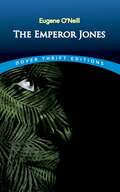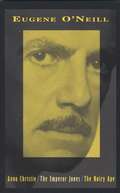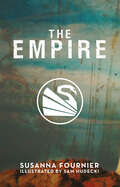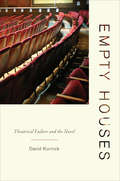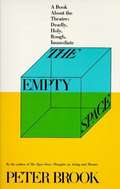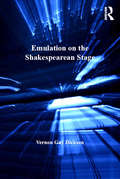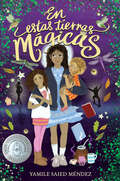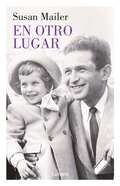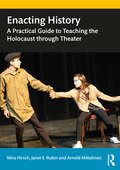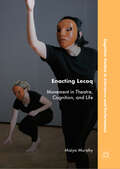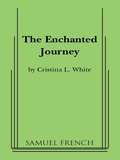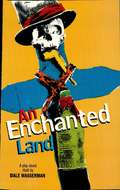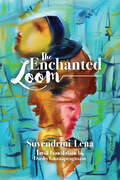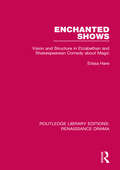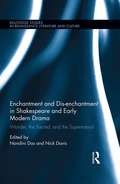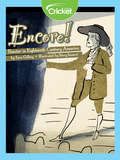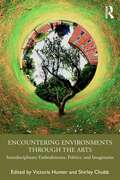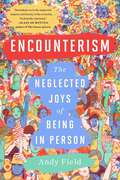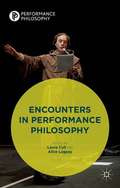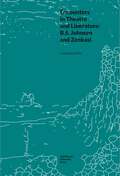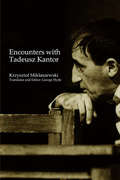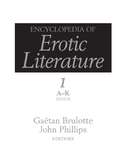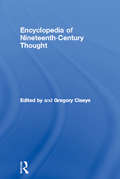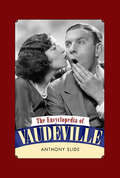- Table View
- List View
The Emperor Jones (Dover Thrift Editions Ser.)
by Eugene O'NeillBrutus Jones, a former Pullman car porter wanted in the United States on two murder charges, has established himself as the self-proclaimed ruler of a West Indian island. Warned that his subjects are about to rebel, he flees to the jungle -- sick with fright -- where he is plagued by ghosts of the men he has murdered and haunted by visions of injustices done to his race. Powerful scenes, punctuated by beating tom-toms, suggest Jones's panic as he flees his angry countrymen and his own personal demons.First produced in 1920, The Emperor Jones helped establish O'Neill's reputation as one of America's most important dramatists. Bold and expressionistic, the play was an instant success on the stage and has remained one of the staples of the dramatic repertoire. It is now available to a wide audience in this attractive, inexpensive Dover Thrift Edition.
The Emperor Jones, Anna Christie, The Hairy Ape
by Eugene O'NeillThree plays by the Nobel Prize winner about people at the base of the social ladder suffering from grief and guilt, as all people can identify with their trials and judgment.
The Emperor's New Clothes: A Comedy For All Ages (Into Reading, Level K #88)
by Hans Anderson Doug RoyNIMAC-sourced textbook
The Empire: A Trilogy of Modern Epics
by Susanna FournierExplore a world on the edge of change through three epic stories spanning five hundred years of imagined history, unpacking systems of power and what we are capable of in the pursuit of freedom. The story starts in The Philosopher’s Wife. Deep in the North, a philosopher exiled for promoting his atheist work amidst a bloody religious war yearns to ignite a revolution, but his personal life has collapsed into chaos. What begins as a desperate attempt to cure his wife’s animalistic behaviour erupts into a power struggle between the sexes, unleashing violent reckonings while the world outside hurtles towards an epoch-changing revolution. Over twenty years later, The Scavenger’s Daughter examines the true face of empire as Northern forces continue to march against the South, “liberating” all who stand in their way. In a landscape blown apart by war, we follow Jack and Ash, orphan soldiers belonging to the Black Swan army, trying to survive the camp, toxic masculinity, and each other until they can be free. When Jack returns to camp, his freedom having been bought for him by a mysterious philosopher, he believes his new life is just around the corner. But as rations wear thin and the king seizes the opium trails, the camp is thrown into chaos, putting everything Jack and Ash have known—including Jack’s first love, Sarah—at risk. Centuries later, in Four Sisters, we meet Sarah again as a woman and former Madam who has survived death, the toppling of regimes, and centuries of war. When a mysterious plague breaks out, she is forced to relocate to a quarantined zone called “The Skirts” with four young girls who were orphaned by the women she once employed. But when a strange doctor arrives and discovers the girls are plague-positive, Sarah must decide whether to go ahead with an experimental treatment or none at all. As time itself begins to erode, this found family of women must face loss, love, and their individual struggles for power in a violent world. For fans of Game of Thrones, The Handmaid’s Tale, and The Mists of Avalon, The Empire is both foreign and shockingly familiar, leaving you asking, how did we get here, and where are we going?
Empty Houses: Theatrical Failure and the Novel
by David KurnickAccording to the dominant tradition of literary criticism, the novel is the form par excellence of the private individual. Empty Houses challenges this consensus by reexamining the genre's development from the mid-nineteenth to the mid-twentieth century and exploring what has until now seemed an anomaly--the frustrated theatrical ambitions of major novelists. Offering new interpretations of the careers of William Makepeace Thackeray, George Eliot, Henry James, James Joyce, and James Baldwin--writers known for mapping ever-narrower interior geographies--this book argues that the genre's inward-looking tendency has been misunderstood. Delving into the critical role of the theater in the origins of the novel of interiority, David Kurnick reinterprets the novel as a record of dissatisfaction with inwardness and an injunction to rethink human identity in radically collective and social terms. Exploring neglected texts in order to reread canonical ones, Kurnick shows that the theatrical ambitions of major novelists had crucial formal and ideological effects on their masterworks. Investigating a key stretch of each of these novelistic careers, he establishes the theatrical genealogy of some of the signal techniques of narrative interiority. In the process he illustrates how the novel is marked by a hunger for palpable collectivity, and argues that the genre's discontents have been a shaping force in its evolution. A groundbreaking rereading of the novel, Empty Houses provides new ways to consider the novelistic imagination.
Empty Space
by Peter BrookFrom director and cofounder of the Royal Shakespeare Company Peter Brook, The Empty Space is a timeless analysis of theatre from the most influential stage director of the twentieth century. As relevant as when it was first published in 1968, groundbreaking director and cofounder of the Royal Shakespeare Company Peter Brook draws on a life in love with the stage to explore the issues facing a theatrical performance—of any scale. He describes important developments in theatre from the last century, as well as smaller scale events, from productions by Stanislavsky to the rise of Method Acting, from Brecht’s revolutionary alienation technique to the free form happenings of the 1960s, and from the different styles of such great Shakespearean actors as John Gielgud and Paul Scofield to a joyous impromptu performance in the burnt-out shell of the Hamburg Opera just after the war. Passionate, unconventional, and fascinating, this book shows how theatre defies rules, builds and shatters illusions, and creates lasting memories for its audiences.
Emulation on the Shakespearean Stage (Studies in Performance and Early Modern Drama)
by Vernon Guy DicksonThe English Renaissance has long been considered a period with a particular focus on imitation; however, much related scholarship has misunderstood or simply marginalized the significance of emulative practices and theories in the period. This work uses the interactions of a range of English Renaissance plays with ancient and Renaissance rhetorics to analyze the conflicted uses of emulation in the period (including the theory and praxis of rhetorical imitatio, humanist notions of exemplarity, and the stage’s purported ability to move spectators to emulate depicted characters). This book emphasizes the need to see emulation not as a solely (or even primarily) literary practice, but rather as a significant aspect of Renaissance culture, giving insight into notions of self, society, and the epistemologies of the period and informed by the period’s own sense of theory and history. Among the individual texts examined here are Shakespeare’s Titus Andronicus and Hamlet, Jonson’s Catiline, and Massinger’s The Roman Actor (with its strong relation to Jonson’s Sejanus).
En estas tierras mágicas
by Yamile Saied MéndezMinerva esta encargada de sus hermanas después de la desaparición de su madre en estamágica historia argentina de medio grado que combina perfectamente con la historia de Peter Pan. Minerva must take care of her sisters after her mother's disappearance in this magical Argentinean middle grade story that pairs perfectly with Peter Pan.Ya a los doce años, Minerva Soledad Miranda está decidida a alcanzar sus metas, a pesar de asumir más responsibilidades que los demás niños de las escuela--como cuidar a sus dos hermanas mientras su mamá maneja dos trabajos. Pero una noche, la mamá de Minerva no regresa a casa y Minerva tiene que decider qué hacer. ¿Fue Mama secuestrada por ICE? ¿Serán las niñas enviadas a hogares de acogida o centros de detención para niños inmigrantes? Minerva y su hermanas no pueden dejar que nadie sepa que mamá ha desparecido. Simplemente fingirán que todo sigue normal hasta que ella regrese. El plan de Minerva se desmorona la primera tarde, cuando su hermanita hace un berrinche durante la audición de Minerva para la obra de Peter Pan. Pero a medida que pasan los días y Minerva se preocupa cada vez más por su madre, algo mágico parece estar cuidándolos: dejándoles pastelitos, ayudándolos a encontrar dinero, e incluso dirigiéndolos a amigos y familiares lejanos que pueden ayudarlos. Eventualmente, Minerva debe tomar la decision más dificil de su vida. Y cuando lo haga, estará preparada para enfrentar los desafíos de la vida, con amistad, esparanza y un poco de magia de hadas. Twelve-year-old Minerva Soledad Miranda is determined to reach her goals, despite shouldering more responsibility than the other kids at school--like caring for her two sisters while her mom works two jobs. But one night, Minerva's mom doesn't come home, and Minerva has to figure out what to do. Was Mamá snapped up by ICE? Will the girls be sent to foster homes or holding centers for migrant kids? Minerva and her sisters can't let anyone know Mamá has disappeared. They'll just pretend everything is normal until she comes back. Minerva's plan falls apart the first afternoon, when her baby sister throws a tantrum during Minerva's audition for Peter Pan. But as the days pass and Minerva grows ever more worried about her mother, something magical seems to be watching out for them: leaving them cupcakes, helping her find money, even steering them to friends and distant family who can help. Eventually, Minerva must make the hardest choice of her life. And when she does, she'll be prepared to face life's challenges--with friendship, hope, and a little bit of fairy magic.
En otro lugar
by Susan MailerUn libro conmovedor y de hondo calado sicológico sobre lo que implicó para descubrir su propio camino ser la hija de uno de los escritores más polémicos y controversiales del siglo XX. En otro lugar es la historia de una hija y de su padre, del vínculo de ambos. Pero no es cualquier padre. Se trata de uno de los más destacados, talentosos y controversiales escritores del siglo XX: Norman Mailer. Conocido por ser un hombre combativo y egoísta, que disfrutaba pelear tanto en lo físico como en lo verbal, estuvo al centro de los grandes debates y discusiones culturales de Estados Unidos durante más de cincuenta años. Se casó seis veces y fue padre de nueve hijos. Susan, nacida en 1949, es la mayor. Sus padres se separaron cuando era bebé, por lo que creció viajando entré México y Nueva York, hasta que se radica en Chile, donde ha vivido gran parte de su vida adulta. Este libro de memorias y recuerdos reconstruye la relación con su padre, intensa y compleja, con sus cinco madrastras y sus 8 hermanos. Cuenta las alegrías y dolores que ha significado para ella ser parte del clan Mailer. Una historia de separación, de las luchas de vivir en dos culturas muy diferentes, un libro sobre el desarraigo y las implicancias de pertenecer a todas partes y a ninguna.
Enacting History: A Practical Guide to Teaching the Holocaust through Theater
by Mira Hirsch Janet E. Rubin Arnold MittelmanEnacting History is a practical guide for educators that provides methodologies and resources for teaching the Holocaust through a variety of theatrical means, including scripted texts, verbatim testimony, devised theater techniques and process-oriented creative exercises. A close collaboration with the USC Shoah Foundation I Witness program and the National Jewish Theater Foundation Holocaust Theater International Initiative at the University of Miami Miller Center for Contemporary Judaic Studies resulted in the ground-breaking work within this volume. The material facilitates teaching the Holocaust in a way that directly connects students to individual people and historical events through the art of theater. Each section is designed to help middle and high school educators meet curricular goals, objectives and standards and to integrate other educational disciplines based upon best practices. Students will gain both intellectual and emotional understanding by speaking the words of survivors, as well as young characters in scripted scenes, and developing their own performances based on historical primary sources. This book is an innovative and invaluable resource for teachers and students of the Holocaust; it is an exemplary account of how the power of theater can be harnessed within the classroom setting to encourage a deeper understanding of this defining event in history.
Enacting Lecoq: Movement In Theatre, Cognition, And Life (Cognitive Studies In Literature And Performance Ser.)
by Maiya MurphyThis book examines the theatrical movement-based pedagogy of Jacques Lecoq (1921-1999) through the lens of the cognitive scientific paradigm of enaction. The conversation between these two both uncovers more of the possible cognitive processes at work in Lecoq pedagogy and proposes how Lecoq’s own practical and philosophical approach could have something to offer the development of the enactive paradigm. Understanding Lecoq pedagogy through enaction can shed new light on the ways that movement, key to Lecoq’s own articulation of his pedagogy, might cognitively constitute the development of Lecoq’s ultimate creative figure – the actor-creator. Through an enactive lens, the actor-creator can be understood as not only a creative figure, but also the manifestation of a fundamentally new mode of cognitive selfhood. This book engages with Lecoq pedagogy’s significant practices and principles including the relationship between the instructor and student, identifications, mime, play, mask work, language, improvisation, and movement analysis.
Enchanted Journey
by Cristina L. WhiteTYA, Children's Theatre \ 4m, 4f \ Simple Set \ A prediction warning Prince Gustav of giants, witches, and danger does not prevent him from traveling to the faraway Kingdom of Lira when he learns his help is needed. He begins a journey which is indeed enchanted, for in the midst of danger he finds unexpected friendship and laughter. Before he reaches Lira, Gustav meets two witches, whose charm makes them unlike any ever encountered, and befriends a coward named Alakazam who travels with him to the dark garden of Gothar the Giant. The journey ends when the surprising and secret ambition of Gothar is learned, and Alakazam achieves his deepest wish through an act of courage.
A Enchanted Land
by Dale WassermanDrama / 8m, 5f / This steamy, tragic tale of love, jealousy, revenge and betrayal in Haiti is by the author of One Flew Over the Cuckoo's Nest.
The Enchanted Loom
by Suvendrini LenaThe Sri Lankan civil war has left many scars on Thangan and his family, most noticeably the loss of his eldest son and the crippling epileptic seizures brought on by his torture. As the final days of the war play out, the family bears witness from their new home of Toronto. Thangan’s other son Kanan comes home from a protest, shaken that someone referred to him by his brother’s name. His young daughter Kavitha innocently dances around with a mysterious pair of anklets that she found. And Thangan’s wife Sevi is consumed with feeling responsible for her broken family. Amidst the ongoing trauma, the family is faced with the possibility of Thangan undergoing neurological surgery. Will the surgery give them a chance to heal, or will it cause even more pain?Presented in both English and Tamil, this poetic play is both medical and mystical, drawing a connection between trauma and memory that creates a stark reminder of loss, hope, family, and freedom.
Enchanted Shows: Vision and Structure in Elizabethan and Shakespearean Comedy about Magic (Routledge Library Editions: Renaissance Drama)
by Elissa HareThe book, first published in 1988, examines the role of magic in Elizabethan and Shakespearean theatre. The author observes how certain plays, including Shakespeare’s A Midsummer Night’s Dream and The Tempest, rationalise the unrealism and improbabilities typical of romantic comedy as miracles wrought by specifically magical intervention. The author also explores the ways in which playwrights justify structural discontinuity by the working of magic. This title will be of interest to students of English Literature, Drama and Performance.
Enchantment and Dis-enchantment in Shakespeare and Early Modern Drama: Wonder, the Sacred, and the Supernatural (Routledge Studies in Renaissance Literature and Culture)
by Nandini Das Nick DavisThis volume addresses dealings with the wondrous, magical, holy, sacred, sainted, numinous, uncanny, auratic, and sacral in the plays of Shakespeare and contemporaries, produced in an era often associated with the irresistible rise of a thinned-out secular rationalism. By starting from the literary text and looking outwards to social, cultural, and historical aspects, it comes to grips with the instabilities of ‘enchanted’ and ‘disenchanted’ practices of thinking and knowledge-making in the early modern period. If what marvelously stands apart from conceptions of the world’s ordinary functioning might be said to be ‘enchanted’, is the enchantedness weakened, empowered, or modally altered by its translation to theatre? We have a received historical narrative of disenchantment as a large-scale early modern cultural process, inexorable in character, consisting of the substitution of a rationally understood and controllable world for one containing substantial areas of mystery. Early modern cultural change, however, involves transpositions, recreations, or fresh inventions of the enchanted, and not only its replacement in diminished or denatured form. This collection is centrally concerned with what happens in theatre, as a medium which can give power to experiences of wonder as well as circumscribe and curtail them, addressing plays written for the popular stage that contribute to and reflect significant contemporary reorientations of vision, awareness, and cognitive practice. The volume uses the idea of dis-enchantment/re-enchantment as a central hub to bring multiple perspectives to bear on early modern conceptualizations and theatricalizations of wonder, the sacred, and the supernatural from different vantage points, marking a significant contribution to studies of magic, witchcraft, enchantment, and natural philosophy in Shakespeare and early modern drama.
Encore! Theater in Eighteenth Century America
by Tara GilboyLewis Hallam Jr. was a theater manager and one of the stars of the early American stage. But it wasn't always easy for theater troupes during this time.
Encountering Environments through the Arts: Interdisciplinary Embodiments, Politics, and Imaginaries
by Victoria Hunter Shirley ChubbThis edited collection of essays and artist reflections presents perspectives from arts and humanities researchers exploring how individuals and collectives engage with, relate to and experience environments. The term environment is broadly conceived in this volume and encompasses rural landscapes and nature spaces, urban and architectural sites, institutional, workplace and organisational spaces, domestic environments and public and private realms.Exploring what it means to encounter environments through embodied, artistic and reflexive practices, the essays and reflections draw on theoretical fields of feminist posthuman discourse, new materialism, anthropology, human geography, queer studies, performing and fine arts, art and health, psychology and ecological perspectives. Drawing on dialogues emerging from discursive border crossings between disciplines, Encountering Environments through the Arts includes contributions from the fields of dance, walking practice, sonic arts, visual art, cultural and human geography, somatic movement practice, poetry and architecture. This collection offers insights and reflections on environment and experience from a range of voices – established and emerging scholars, independent researchers and practitioner-researchers within and beyond the academy.Providing a truly interdisciplinary range of research that centres on notions of site-specific practice and experience, this is an invaluable contribution to performance studies and the wider field of arts and humanities. The reflective accounts and articulation of research methods and approaches make this volume ideal for undergraduate and postgraduate students as well as scholars and researchers of performance studies, dance and choreography studies, cultural studies, environmental humanities, arts and social sciences.
Encounterism: The Neglected Joys of Being In Person
by Andy FieldA playful, analytical, informed, and poetic exploration of the delight and transformative power of real-life encounters. The light touch of a hairdresser’s hands on one’s scalp, the euphoric energy of a nightclub, huddling with strangers under a shelter in the rain, a spontaneous snowball fight in the street, a daily interaction with a homeless man—such mundane connections, when we closely inhabit the same space, and touch or are touched by others, were nearly lost to “social distancing.” Will we ever again shake hands without a thought? In this deeply rewarding book, Andy Field brings together history, science, psychology, queer theory, and pop culture with his love of urban life and his own experiences—both as a city-dweller and as a performance artist—to forge creative connections: walking hand-in-hand with strangers, knocking on doors, staging encounters in parked cars. In considering twelve different kinds of encounters, from car rides to video calls to dog-walker chats in the park, Field argues “that in the spontaneity and joy of our meetings with each other, we might find the faint outline of a better future.”
Encounters in Performance Philosophy
by Laura Cull Alice LagaayEncounters in Performance Philosophy is a collection of 14 essays by international researchers which demonstrates the vitality of the field of Performance Philosophy. The essays address a wide range of concerns common to performance and philosophy including: the body, language, performativity, mimesis and tragedy.
Encounters in Theatre and Liberature: B.S. Johnson and Zenkasi (Topographies of (Post)Modernity: Studies in 20th and 21st Century Literature in English)
by Katarzyna BielaIn his essay-manifesto of 1999, Zenon Fajfer defined liberature – a literary genre encompassing works whose authors intentionally design the shape of the book, so that it matches their textual message. Extending beyond the growing literary research on liberature, this book presents the theatrical contexts of the genre. Grounded in original archival research, it discusses the theatre practice of Zenon Fajfer and Katarzyna Bazarnik (Zenkasi), as well as the post-war British avant-garde author, B.S. Johnson, whom they see as as a liberatic author avant la lettre. Tracking the connections between their work work in different media, the monograph considers how their theatrical experience may be related to the invention of unconventional aesthetic solutions in literature.
Encounters with Tadeusz Kantor (Routledge Harwood Polish And East European Theatre Archive Ser.)
by Krzysztof MiklaszewskiAn invaluable collection of documents and discussions of the work of one of the most significant theatre practitioners of the last fifty years.This unique set of reminiscences, written by one of the actors who worked closely with Kantor over a long period of time, ranges from the anecdotal to the theoretical. Kantor's work offers some of the most disconcerting allegories of Modernism and a quintessential expression of the unconscious during a bitter period of human history. Kantor's stern but affectionate guardianship of his troupe of travelling players comes off Miklaszewski's pages with warmth, humanity and humour.
Encyclopedia of Erotic Literature
by Ga John PhillipsThe Encyclopedia of Erotic Literature is a two-volume work that contains some 540 entries on erotic literature on an international scale. The Encyclopedia has an unprecedented scope, the first scholarly reference resource to bring the field together in all its fascinating variety. The entries examine the history of the literature in different countries and languages from classical antiquity to the present day, individual writers from around the world (not all of them necessarily known as specialist writers of erotic literature), significant works, genres and critical approaches, and general themes pertinent to erotic literature (nudity, prostitution, etc.). The definition of erotic literature is broad, encompassing all the material recognized in the study of the field: not just fiction in all genres (novels, poetry, short stories, drama), but also essays, autobiographies, treatises and sex manuals from different cultures. This Encyclopedia deals with sexually explicit texts characterized by sexual representations and suggestions. All types of sexuality are included. For more information about the title and the editors, go to: http://www.londonmet.ac.uk/news/latest-news/erotic-encyclopedia-edited-by-london-met-professor.cfm/
Encyclopedia of Nineteenth Century Thought
by Gregory ClaeysEncyclopedia of Nineteenth Century Thought provides essential information on, and a critical interpretation of, nineteenth-century thought and nineteenth-century thinkers. The project takes as its temporal boundary the period 1789 to 1914. Encyclopedia of Nineteenth Century Thought primarily covers social and political thinking, but key entries also survey science, religion, law, art, concepts of modernity, the body and health, and so on, and thereby take into account all of the key developments in the intellectual history of the period. The encyclopedia is alphabetically organized, and consists of:* principal entries, divided into ideas (4000 words) and persons (2500 words)* subsidiary entries of 1000 words, which are entirely biographical* informational entries of 500 words, which are also biographical.
The Encyclopedia of Vaudeville
by Anthony SlideThe Encyclopedia of Vaudeville provides a unique record of what was once America's preeminent form of popular entertainment from the late 1800s through the early 1930s. It includes entries not only on the entertainers themselves, but also on those who worked behind the scenes, the theatres, genres, and historical terms. Entries on individual vaudevillians include biographical information, samplings of routines and, often, commentary by the performers. Many former vaudevillians were interviewed for the book, including Milton Berle, Block and Sully, Kitty Doner, Fifi D'Orsay, Nick Lucas, Ken Murray, Fayard Nicholas, Olga Petrova, Rose Marie, Arthur Tracy, and Rudy Vallee. Where appropriate, entries also include bibliographies. The volume concludes with a guide to vaudeville resources and a general bibliography. Aside from its reference value, with its more than five hundred entries, The Encyclopedia of Vaudeville discusses the careers of the famous and the forgotten. Many of the vaudevillians here, including Jack Benny, George Burns and Gracie Allen, Jimmy Durante, W. C. Fields, Bert Lahr, and Mae West, are familiar names today, thanks to their continuing careers on screen. At the same time, and given equal coverage, are forgotten acts: legendary female impersonators Bert Savoy and Jay Brennan, the vulgar Eva Tanguay with her billing as “The I Don't Care Girl,” male impersonator Kitty Doner, and a host of “freak” acts.
